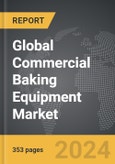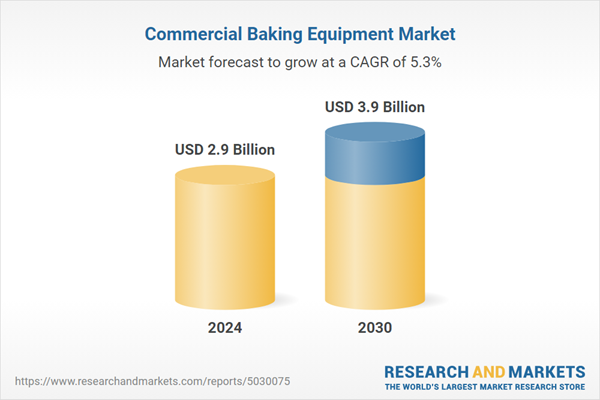The global market for Commercial Baking Equipment was valued at US$2.9 Billion in 2024 and is projected to reach US$3.9 Billion by 2030, growing at a CAGR of 5.3% from 2024 to 2030. This comprehensive report provides an in-depth analysis of market trends, drivers, and forecasts, helping you make informed business decisions. The report includes the most recent global tariff developments and how they impact the Commercial Baking Equipment market.
Segments: Product (Ovens, Mixers, Bakery Display Cases, Bread Slicers, Dividers & Sheeters, Holding & Proofing, Accessories).
Geographic Regions/Countries: World; United States; Canada; Japan; China; Europe (France; Germany; Italy; United Kingdom; Spain; Russia; and Rest of Europe); Asia-Pacific (Australia; India; South Korea; and Rest of Asia-Pacific); Latin America (Argentina; Brazil; Mexico; and Rest of Latin America); Middle East (Iran; Israel; Saudi Arabia; United Arab Emirates; and Rest of Middle East); and Africa.
The analysts continuously track trade developments worldwide, drawing insights from leading global economists and over 200 industry and policy institutions, including think tanks, trade organizations, and national economic advisory bodies. This intelligence is integrated into forecasting models to provide timely, data-driven analysis of emerging risks and opportunities.
Global Commercial Baking Equipment Market - Key Trends and Drivers Summarized
How Does Commercial Baking Equipment Support Large-Scale Production?
Commercial baking equipment plays a pivotal role in enabling large-scale production in bakeries, restaurants, and food manufacturing facilities. Unlike domestic baking appliances, commercial baking equipment is designed to handle high volumes of production, ensuring consistency, efficiency, and reliability even under continuous operation. These machines are built to automate various baking processes, such as mixing, proofing, baking, and cooling, thus significantly reducing manual labor and time. Ovens, one of the key components of commercial baking equipment, come in various forms, including convection ovens, deck ovens, and rotary ovens, each designed for different types of baked goods. They offer uniform heat distribution, ensuring that large batches of bread, pastries, or cakes are baked evenly. Similarly, commercial mixers and dough processors are essential in preparing large quantities of dough with consistent quality. These machines are often equipped with programmable settings that allow bakers to customize the mixing process according to specific recipes, enhancing product consistency across production runs. The high capacity and durability of commercial baking equipment are critical for meeting the demands of busy commercial kitchens and industrial baking facilities, where downtime or inconsistency can lead to significant financial losses.What Technological Innovations Are Shaping Commercial Baking Equipment?
The commercial baking equipment industry has undergone significant technological advancements in recent years, aimed at improving efficiency, precision, and flexibility. One of the most notable innovations is the integration of automation into baking processes. Automated systems are capable of handling multiple steps of production, from mixing and shaping to baking and packaging, without the need for constant human intervention. This not only increases production speed but also reduces the risk of human error, ensuring uniformity in the final product. Moreover, intelligent control systems are being incorporated into commercial ovens and mixers, allowing for greater precision in temperature, timing, and humidity levels. These systems can be pre-programmed for specific recipes and even adjusted in real-time based on sensor feedback. Another key innovation is the rise of energy-efficient baking equipment. With growing environmental concerns and increasing energy costs, manufacturers are designing ovens and proofers that consume less power without compromising on performance. Features such as heat recovery systems and better insulation are becoming standard in modern commercial ovens, reducing energy waste. Additionally, the development of specialized equipment, such as gluten-free or allergen-friendly baking machinery, is enabling bakeries to cater to the growing demand for specialty products while ensuring contamination-free production lines.What Are The Latest Trends In Commercial Baking Equipment?
Several trends are influencing the commercial baking equipment industry, reflecting broader shifts in consumer preferences, sustainability efforts, and technological advancements. One of the most prominent trends is the demand for multifunctional equipment that can perform various tasks within a compact footprint. As space in commercial kitchens and bakeries is often limited, equipment that can mix, knead, and bake all in one unit is highly sought after. These versatile machines not only save space but also reduce the need for multiple specialized machines, streamlining operations. Another significant trend is the growing focus on sustainability. Many bakeries and food production facilities are seeking energy-efficient baking solutions to reduce their environmental footprint. Equipment manufacturers are responding by offering energy-saving ovens with advanced insulation, as well as mixers and proofers that operate at lower power levels. Additionally, as the demand for healthier baked goods rises, there is a growing need for equipment that can handle alternative ingredients like whole grains, organic flours, and gluten-free products. Commercial baking equipment designed for these specialized processes ensures consistent quality even when working with non-traditional ingredients that may require different handling techniques. The rise of digitalization and smart technology is also transforming the industry, with remote monitoring and predictive maintenance systems becoming more common, allowing bakery owners to optimize production schedules and minimize downtime.What Factors Are Fueling Expansion of the Commercial Baking Equipment Market?
The growth in the commercial baking equipment market is driven by several factors, including technological advancements, changing consumer demands, and the expansion of food service and bakery industries globally. A major driver is the increasing demand for automation in commercial kitchens and food manufacturing facilities, as businesses seek to improve efficiency and reduce labor costs. Automated baking systems that streamline production processes, such as mixing, baking, and packaging, are becoming essential for bakeries and large-scale food manufacturers that need to produce consistent, high-quality products at a rapid pace. The rising trend of artisanal and specialty baked goods is also contributing to market growth, as bakeries invest in specialized equipment capable of handling non-traditional ingredients or producing unique textures and flavors. Additionally, the global expansion of quick-service restaurants (QSRs) and food chains is creating demand for high-capacity commercial baking equipment that can meet the needs of large-scale operations. Consumer preferences for healthier and allergen-free products are influencing equipment manufacturers to design machinery that can handle diverse ingredient types and recipes. Finally, the push toward energy efficiency and sustainability in commercial kitchens is encouraging the adoption of energy-saving equipment, which helps businesses reduce operating costs while complying with environmental regulations.Report Scope
The report analyzes the Commercial Baking Equipment market, presented in terms of units. The analysis covers the key segments and geographic regions outlined below.Segments: Product (Ovens, Mixers, Bakery Display Cases, Bread Slicers, Dividers & Sheeters, Holding & Proofing, Accessories).
Geographic Regions/Countries: World; United States; Canada; Japan; China; Europe (France; Germany; Italy; United Kingdom; Spain; Russia; and Rest of Europe); Asia-Pacific (Australia; India; South Korea; and Rest of Asia-Pacific); Latin America (Argentina; Brazil; Mexico; and Rest of Latin America); Middle East (Iran; Israel; Saudi Arabia; United Arab Emirates; and Rest of Middle East); and Africa.
Key Insights:
- Market Growth: Understand the significant growth trajectory of the Ovens segment, which is expected to reach US$1.2 Billion by 2030 with a CAGR of a 5.4%. The Mixers segment is also set to grow at 5.3% CAGR over the analysis period.
- Regional Analysis: Gain insights into the U.S. market, valued at $753.8 Million in 2024, and China, forecasted to grow at an impressive 8.2% CAGR to reach $896.5 Million by 2030. Discover growth trends in other key regions, including Japan, Canada, Germany, and the Asia-Pacific.
Why You Should Buy This Report:
- Detailed Market Analysis: Access a thorough analysis of the Global Commercial Baking Equipment Market, covering all major geographic regions and market segments.
- Competitive Insights: Get an overview of the competitive landscape, including the market presence of major players across different geographies.
- Future Trends and Drivers: Understand the key trends and drivers shaping the future of the Global Commercial Baking Equipment Market.
- Actionable Insights: Benefit from actionable insights that can help you identify new revenue opportunities and make strategic business decisions.
Key Questions Answered:
- How is the Global Commercial Baking Equipment Market expected to evolve by 2030?
- What are the main drivers and restraints affecting the market?
- Which market segments will grow the most over the forecast period?
- How will market shares for different regions and segments change by 2030?
- Who are the leading players in the market, and what are their prospects?
Report Features:
- Comprehensive Market Data: Independent analysis of annual sales and market forecasts in US$ Million from 2024 to 2030.
- In-Depth Regional Analysis: Detailed insights into key markets, including the U.S., China, Japan, Canada, Europe, Asia-Pacific, Latin America, Middle East, and Africa.
- Company Profiles: Coverage of players such as Alto-Shaam, Inc., Baker Perkins Ltd., Blodgett Corporation, Channel Manufacturing, Doyon & NU-VU and more.
- Complimentary Updates: Receive free report updates for one year to keep you informed of the latest market developments.
Some of the 106 companies featured in this Commercial Baking Equipment market report include:
- Alto-Shaam, Inc.
- Baker Perkins Ltd.
- Blodgett Corporation
- Channel Manufacturing
- Doyon & NU-VU
- Empire Bakery Equipment
- Eurodib Inc.
- Globe Food Equipment Company
- Hobart
- ITW Food Equipment Group LLC-Vulcan
- Middleby Celfrost Innovations (P) Ltd.
- NU-VU Food Service Systems
- Robot Coupe
Tariff Impact Analysis: Key Insights for 2025
Global tariff negotiations across 180+ countries are reshaping supply chains, costs, and competitiveness. This report reflects the latest developments as of April 2025 and incorporates forward-looking insights into the market outlook.The analysts continuously track trade developments worldwide, drawing insights from leading global economists and over 200 industry and policy institutions, including think tanks, trade organizations, and national economic advisory bodies. This intelligence is integrated into forecasting models to provide timely, data-driven analysis of emerging risks and opportunities.
What’s Included in This Edition:
- Tariff-adjusted market forecasts by region and segment
- Analysis of cost and supply chain implications by sourcing and trade exposure
- Strategic insights into geographic shifts
Buyers receive a free July 2025 update with:
- Finalized tariff impacts and new trade agreement effects
- Updated projections reflecting global sourcing and cost shifts
- Expanded country-specific coverage across the industry
Table of Contents
I. METHODOLOGYII. EXECUTIVE SUMMARY2. FOCUS ON SELECT PLAYERSIII. MARKET ANALYSISSOUTH KOREAREST OF ASIA-PACIFICARGENTINABRAZILMEXICOREST OF LATIN AMERICAIRANISRAELSAUDI ARABIAUNITED ARAB EMIRATESREST OF MIDDLE EASTIV. COMPETITION
1. MARKET OVERVIEW
3. MARKET TRENDS & DRIVERS
4. GLOBAL MARKET PERSPECTIVE
UNITED STATES
CANADA
JAPAN
CHINA
EUROPE
FRANCE
GERMANY
ITALY
UNITED KINGDOM
SPAIN
RUSSIA
REST OF EUROPE
ASIA-PACIFIC
AUSTRALIA
INDIA
LATIN AMERICA
MIDDLE EAST
AFRICA
Companies Mentioned (Partial List)
A selection of companies mentioned in this report includes, but is not limited to:
- Alto-Shaam, Inc.
- Baker Perkins Ltd.
- Blodgett Corporation
- Channel Manufacturing
- Doyon & NU-VU
- Empire Bakery Equipment
- Eurodib Inc.
- Globe Food Equipment Company
- Hobart
- ITW Food Equipment Group LLC-Vulcan
- Middleby Celfrost Innovations (P) Ltd.
- NU-VU Food Service Systems
- Robot Coupe
Table Information
| Report Attribute | Details |
|---|---|
| No. of Pages | 353 |
| Published | April 2025 |
| Forecast Period | 2024 - 2030 |
| Estimated Market Value ( USD | $ 2.9 Billion |
| Forecasted Market Value ( USD | $ 3.9 Billion |
| Compound Annual Growth Rate | 5.3% |
| Regions Covered | Global |









